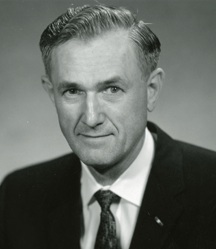
THE “FATHER OF ELECTRONIC WARFARE”
Major and graduation year: Electrical Engineering, BS ‘35
Career success: After five years of designing commercial radios and components for Colonial Radio and Zenith Radio, alumnus Howard O. Lorenzen became an electrical engineer at the Naval Research Laboratory (NRL) in 1940. During his career, Lorenzen helped with developments in radar, electronic countermeasures systems, and intelligence satellite designs. Lorenzen led the NRL’s Galactic Radiation and Background (GRAB) program, the earliest successful American reconnaissance satellite program and the first electronic intelligence satellite. His electronic countermeasures discipline detected any electromagnetic energy that an enemy might transmit for military purposes and either interfered with or took advantage of it for intelligence purposes.
The best defense: Lorenzen went on to become the NRL’s first superintendent of electronic warfare in 1966. During that time, he led the development of defense equipment for naval aircraft to guard against guided missiles. He also helped develop America’s first portable radar equipment. His electronic countermeasures research after World War II helped immensely during the Cold War, where his ideas were used successfully with Soviet technology.
The sky’s the limit: In 1971, Lorenzen was made superintendent of space systems for the NRL. He oversaw the development of payload electronics and ground readout systems for communications, ocean surveillance, early global positioning systems (GPS) technology, and more. Lorenzen retired in 1973, and he passed away in 2000.
A lasting legacy: Lorenzen’s innovations and breakthroughs led him to be considered by many to be “the father of electronic warfare.” In 2010, the U.S. Navy named the USNS Lorenzen – a 12,575-ton, 534-foot-long, missile range instrumentation ship–after him. Technology Lorenzen and his colleagues developed were the foundation of the electronic warfare today.